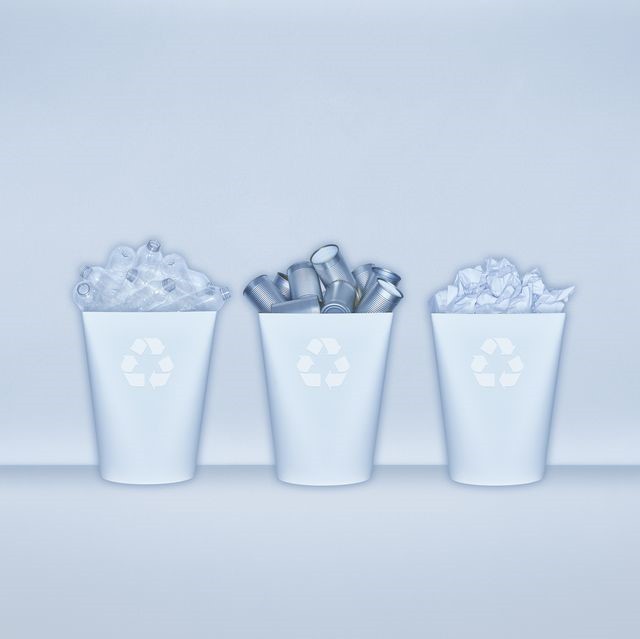Exactly What Every Plastic Recycling Symbol Actually Means
Plus, how to recycle the different types of plastics.
BY BRIAN CLARK HOWARD AND AMINA LAKE ABDELRAHMAN, GOOD HOUSEKEEPING INSTITUTE
Feb 26, 2020
Sometimes it seems like everything in modern America is made of plastic. The versatile material is in our cars, toys, packaging, clothing, home goods, food utensils, and so much more — but it’s also littering our streets, clogging our waterways, and choking marine life. In fact, one 2016 study found that 32% of plastic packaging ends up in our oceans every year.
Many plastics can be readily recycled, but according to National Geographic, a whopping 91% of plastic has never even been recycled. With all the different rules and symbols, it can be confusing for consumers to figure out exactly what each plastic recycling symbol means and how to recycle it. While the universal plastic resin symbol (three chasing arrows forming a triangle) remains the same, the numbers one through seven inside make a significant difference. FYI: Just because a product has the chasing arrows symbol, doesn’t mean it’s recyclable — it’s just an indicator of the type of plastic.
Here at the Good Housekeeping Institute, our team is passionate about sustainability and the environment. From helping you decode eco-friendly claims to sharing the winners of our first-ever Sustainable Packaging Awards, we’re here to help you make smarter decisions for your home and the environment. First, read up on recycling tips from our environmental experts.
How to know what plastics can be recycled
Every town and city has different recycling programs, so you’ll often have to check your location’s rules to find out exactly what you can recycle. Plus, “there are times when your recycling program may change what it collects,” says Mike Brown of Brown and Wilmanns Environmental, one of our environmental consultants. Even if there isn’t a way for your town to recycle a certain material, he says there’s still a chance they might collect it anyways and either store it or dispose of it.
Of course, the symbols themselves need explaining, too. Here’s what each plastic recycling symbol means, along with examples it’s found in and how to recycle it.
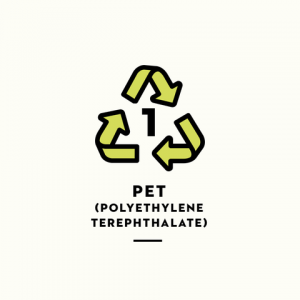
بازیافت PET
1
Plastic Recycling Symbol #1: PET or PETE
PET or PETE (polyethylene terephthalate) is the most common plastic for single-use bottled beverages, because it’s inexpensive, lightweight, and easy to recycle. It poses low risk of leaching breakdown products. Its recycling rates remain relatively low (around 20%), even though the material is in high demand by manufacturers.
Found in: Soft drinks, water, ketchup, and beer bottles; mouthwash bottles; peanut butter containers; salad dressing and vegetable oil containers
How to recycle it: PET or PETE can be picked up through most curbside recycling programs as long as it’s been emptied and rinsed of any food. When it comes to caps, our environmental pros say it’s probably better to dispose of them in the trash (since they’re usually made of a different type of plastic), unless your town explicitly says you can throw them in the recycle bin. There’s no need to remove bottle labels because the recycling process separates them.
Recycled into: Polar fleece, fiber, tote bags, furniture, carpet, paneling, straps, bottles and food containers (as long as the plastic being recycled meets purity standards and doesn’t have hazardous contaminants)
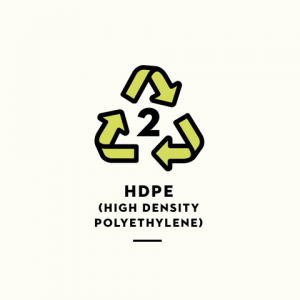
HDPE RECYCLING
2
Plastic Recycling Symbol #2: HDPE
HDPE (high density polyethylene) is a versatile plastic with many uses, especially when it comes to packaging. It carries low risk of leaching and is readily recyclable into many types of goods.
Found in: Milk jugs; juice bottles; bleach, detergent, and other household cleaner bottles; shampoo bottles; some trash and shopping bags; motor oil bottles; butter and yogurt tubs; cereal box liners
How to recycle it: HDPE can often be picked up through most curbside recycling programs, although some allow only containers with necks. Flimsy plastics (like grocery bags and plastic wrap) usually can’t be recycled, but some stores will collect and recycle them.
Recycled into: Laundry detergent bottles, oil bottles, pens, recycling containers, floor tile, drainage pipe, lumber, benches, doghouses, picnic tables, fencing, shampoo bottles
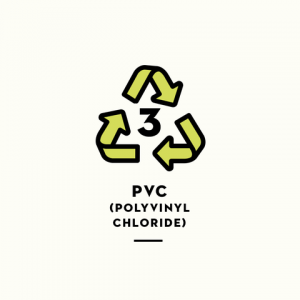
PVC recycling
3
Plastic Recycling Symbol #3: PVC or V
PVC (polyvinyl chloride) and V (vinyl) is tough and weathers well, so it’s commonly used for things like piping and siding. PVC is also cheap, so it’s found in plenty of products and packaging. Because chlorine is part of PVC, it can result in the release of highly dangerous dioxins during manufacturing. Remember to never burn PVC, because it releases toxins.
Found in: Shampoo and cooking oil bottles, blister packaging, wire jacketing, siding, windows, piping
How to recycle it: PVC and V can rarely be recycled, but it’s accepted by some plastic lumber makers. If you need to dispose of either material, ask your local waste management to see if you should put it in the trash or drop it off at a collection center.
Recycled into: Decks, paneling, mud-flaps, roadway gutters, flooring, کابل ها, speed bumps, mats
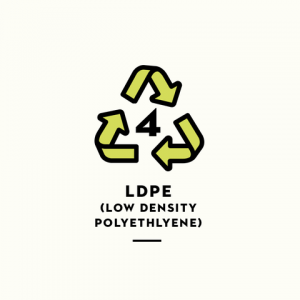
LDPE recycling
4
Plastic Recycling Symbol #4: LDPE
LDPE (low density polyethylene) is a flexible plastic with many applications. Historically, it hasn’t been accepted through most American recycling programs, but more and more communities are starting to accept it.
Found in: Squeezable bottles; bread, frozen food, dry cleaning, and shopping bags; tote bags; furniture
How to recycle it: LDPE is not often recycled through curbside programs, but some communities might accept it. That means anything made with LDPE (like toothpaste tubes) can be thrown in the trash. Just like we mentioned under HDPE, plastic shopping bags can often be returned to stores for recycling.
Recycled into: Trash can liners and cans, compost bins, shipping envelopes, paneling, lumber, landscaping ties, floor tile
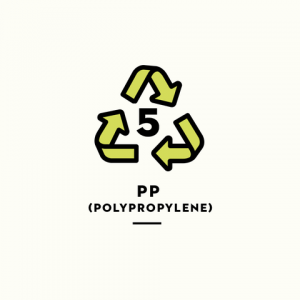
PP recycling
5
Plastic Recycling Symbols #5: PP
PP (polypropylene) has a high melting point, so it’s often chosen for containers that will hold hot liquid. It’s gradually becoming more accepted by recyclers.
Found in: Some yogurt containers, syrup and medicine bottles, caps, straws
How to recycle it: PP can be recycled through some curbside programs, just don’t forget to make sure there’s no food left inside. It’s best to throw loose caps into the garbage since they easily slip through screens during recycling and end up as trash anyways.
Recycled into: Signal lights, battery cables, brooms, brushes, auto battery cases, ice scrapers, landscape borders, bicycle racks, rakes, bins, pallets, trays
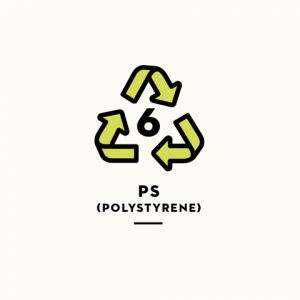
PS recycling
6
Plastic Recycling Symbol #6: PS
PS (polystyrene) can be made into rigid or foam products — in the latter case it is popularly known as the trademark Styrofoam. Styrene monomer (a type of molecule) can leach into foods and is a possible human carcinogen, while styrene oxide is classified as a probable carcinogen. The material was long on environmentalists’ hit lists for dispersing widely across the landscape, and for being notoriously difficult to recycle. Most places still don’t accept it in foam forms because it’s 98% air.
Found in: Disposable plates and cups, meat trays, egg cartons, carry-out containers, aspirin bottles, compact disc cases
How to recycle it: Not many curbside recycling programs accept PS in the form of rigid plastics (and many manufacturers have switched to using PET instead). Since foam products tend to break apart into smaller pieces, you should place them in a bag, squeeze out the air, and tie it up before putting it in the trash to prevent pellets from dispersing.
Recycled into: Insulation, light switch plates, egg cartons, vents, rulers, foam packing, carry-out containers
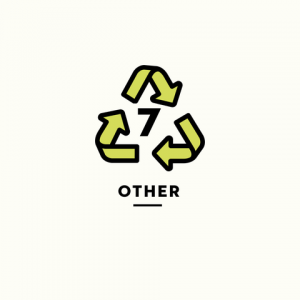
Others recycling
7
Plastic Recycling Symbol #7: Miscellaneous
A wide variety of plastic resins that don’t fit into the previous categories are lumped into this one. Polycarbonate is number seven plastic, and it’s the hard plastic that has worried parents after studies have shown it as a hormone disruptor. PLA (polylactic acid), which is made from plants and is carbon neutral, also falls into this category.
Found in: Three- and five-gallon water bottles, bullet-proof materials, sunglasses, DVDs, iPod and computer cases, signs and displays, certain food containers, nylon
How to recycle it: These other plastics are traditionally not recycled, so don’t expect your local provider to accept them. The best option is to consult your municipality’s website for specific instructions.
Recycled into: Plastic lumber and custom-made products
Repost from: https://www.goodhousekeeping.com/home/g804/recycling-symbols-plastics-460321/#
If the infringement please contact delete

